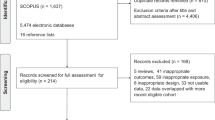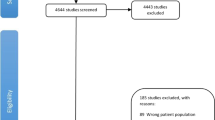Abstract
Background
Previous studies have observed inconsistent associations between birth weight and aggressive prostate cancer risk. This study aimed to prospectively analyse this association in the Health Professionals Follow-up Study (HPFS).
Methods
Birth weight was self-reported in 1994, and prostate cancer diagnoses were assessed biennially through January 2017 and confirmed by medical record review. Multivariable Cox proportional hazards regression was used to evaluate the association between birth weight and prostate cancer risk and mortality.
Results
Among 19,889 eligible men, 2520 were diagnosed with prostate cancer, including 643 with higher-grade/advanced stage, 296 with lethal, and 248 with fatal disease. Overall, no association was observed for increasing birth weight with risk of overall prostate cancer, lower-grade, and organ-confined disease. However, a borderline statistically significant positive trend was observed for increasing birth weight with risk of higher-grade and/or advanced-stage prostate cancer (adjusted hazard ratio [HRadj] per pound: 1.05; 95% confidence interval [CI]: 0.99–1.11; P-trend = 0.08), but no associations were observed with risk of lethal or fatal disease (HRadj: 0.99, 95% CI: 0.91–1.08; P-trend = 0.83; and HRadj: 0.99, 95% CI: 0.90–1.08; P-trend = 0.82, respectively).
Conclusion
No consistent associations were observed between birth weight and prostate cancer risk or mortality in this 22-year prospective cohort study.
This is a preview of subscription content, access via your institution
Access options
Subscribe to this journal
Receive 24 print issues and online access
$259.00 per year
only $10.79 per issue
Buy this article
- Purchase on Springer Link
- Instant access to full article PDF
Prices may be subject to local taxes which are calculated during checkout
Similar content being viewed by others
Data availability
The data analysed in this study are not publicly available due to restrictions set by the data holder but may be made available for collaborating researchers upon request.
References
Xia T, Blackburn WR, Gardner WA Jr. Fetal prostate growth and development. Pediatr Pathol. 1990;10:527–37.
Humphrey PA. Prostate pathology. Chicago: American society for clinical pathology; 2003.
Risbridger GP, Almahbobi GA, Taylor RA. Early prostate development and its association with late-life prostate disease. Cell Tissue Res. 2005;322:173–81.
Trichopoulos D, Lipworth L. Is cancer causation simpler than we thought, but more intractable? Epidemiology. 1995;6:347–9.
Loeb LA. Microsatellite instability: marker of a mutator phenotype in cancer. Cancer Res. 1994;54:5059–63.
Ekbom A. Growing evidence that several human cancers may originate in utero. Semin Cancer Biol. 1998;8:237–44.
NIH. Cancer Stat Facts: Prostate Cancer. [cited 2023 Nov 15]. Available from: https://seer.cancer.gov/statfacts/html/prost.html.
Sutcliffe S, Colditz GA. Prostate cancer: is it time to expand the research focus to early-life exposures? Nat Rev Cancer. 2013;13:208–518.
Tibblin G, Eriksson M, Cnattingius S, Ekbom A. High birthweight as a predictor of prostate cancer risk. Epidemiology. 1995;6:423–4.
Zhou CK, Sutcliffe S, Welsh J, Mackinnon K, Kuh D, Hardy R, et al. Is birthweight associated with total and aggressive/lethal prostate cancer risks? A systematic review and meta-analysis. Br J Cancer. 2016;114:839–48.
Sharma S, Kohli C, Johnson L, Bennet L, Brusselaers N, Nilsson PM. Birth size and cancer prognosis: a systematic review and meta-analysis. J Dev Orig Health Dis. 2020;11:309–16.
Platz EA, Giovannucci E, Rimm EB, Curhan GC, Spiegelman D, Colditz G, et al. Retrospective analysis of birth weight and prostate cancer in the Health Professionals Follow-up Study. Am J Epidemiol. 1998;147:1140–4.
Rosenblatt KA, Wicklund KG, Stanford JL. Sexual factors and the risk of prostate cancer. Am J Epidemiol. 2001;153:1152–8.
Curhan GC, Willett WC, Rimm EB, Spiegelman D, Ascherio AL, Stampfer MJ. Birth weight and adult hypertension, diabetes mellitus, and obesity in US men. Circulation. 1996;94:3246–50.
Giovannucci E, Liu Y, Platz EA, Stampfer MJ, Willett WC. Risk factors for prostate cancer incidence and progression in the health professionals follow-up study. Int J Cancer. 2007;121:1571–8.
Sutcliffe S, Giovannucci E, Willett W, Platz E. A prospective study of birth weight and risk of prostate cancer. Cancer Res 2007;67(9_Supplement):3446–3446.
Ahlgren M, Wohlfahrt J, Olsen LW, Sørensen TI, Melbye M. Birth weight and risk of cancer. Cancer. 2007;110:412–9.
Cote DJ, Downer MK, Smith TR, Smith-Warner SA, Egan KM, Stampfer MJ. Height, waist circumference, body mass index, and body somatotype across the life course and risk of glioma. Cancer Causes Control. 2018;29:707–19.
Acknowledgements
We would like to thank the following state cancer registries for their help: AL, AZ, AR, CA, CO, CT, DE, FL, GA, ID, IL, IN, IA, KY, LA, ME, MD, MA, MI, NE, NH, NJ, NY, NC, ND, OH, OK, OR, PA, RI, SC, TN, TX, VA, WA and WY. We are also grateful to the Health Professionals Follow-up Study participants, and research staff. In particular, we are grateful to Ruifeng Li for reviewing the statistical analysis programs. The authors assume full responsibility for analyses and interpretation of these data.
Funding
The HPFS cohort is funded by research grant NCI U01 167552 (Harvard). This project was supported by the Fund for Research and Progress in Urology, Johns Hopkins Medical Institutions (SS); Barnes-Jewish Hospital Foundation (SS); the Alvin J. Siteman Comprehensive Cancer Center (P30CA091842, SS); the Washington University School of Medicine Institute for Clinical and Translational Sciences (UL1 TR002345, SS); the Sidney Kimmel Comprehensive Cancer Center (P50CA58236, EAP); and the American Cancer Society (Grant CRP-23-1014041, ELG). The funders had no role in the design or conduct of the study; collection, management, analysis, or interpretation of the data; preparation, review, or approval of the manuscript; or the decision to submit the manuscript for publication.
Author information
Authors and Affiliations
Contributions
Study concept and design: QL, ELG, EAP and SS. Acquisition of the data: JBV, LAM and ELG. Analysis and interpretation of the data: QL, YZ, JBV, LAM, ELG, EAP and SS. Drafting of the manuscript: QL. Critical revision of the manuscript for important intellectual content: QL, YZ, JBV, LAM, ELG, EAP and SS. Statistical analysis: QL, YZ and SS. Funding acquisition: LAM and ELG. Administrative, technical, or material support: YZ, JBV, LAM, ELG, EAP and SS. Study supervision: SS.
Corresponding author
Ethics declarations
Competing interests
Dr. Mucci reports the following disclosures: she received research funding from Astra Zeneca, Janssen, and Veracyte; was a consultant to Bayer; and is on the SAB and has equity interests in Convergent TX. None of these activities are relevant to the current study. The remaining authors declare no competing interests.
Ethics approval and consent to participate
The study protocol was approved by the institutional review boards of the Brigham and Women’s Hospital and Harvard T.H. Chan School of Public Health, as well as those of participating registries as required.
Consent for publication
Not applicable.
Additional information
Publisher’s note Springer Nature remains neutral with regard to jurisdictional claims in published maps and institutional affiliations.
Supplementary information
Rights and permissions
Springer Nature or its licensor (e.g. a society or other partner) holds exclusive rights to this article under a publishing agreement with the author(s) or other rightsholder(s); author self-archiving of the accepted manuscript version of this article is solely governed by the terms of such publishing agreement and applicable law.
About this article
Cite this article
Liu, Q., Zhang, Y., Vaselkiv, J.B. et al. A prospective study of birth weight and prostate cancer risk and mortality in the Health Professionals Follow-up Study. Br J Cancer 130, 1295–1303 (2024). https://doi.org/10.1038/s41416-024-02593-y
Received:
Revised:
Accepted:
Published:
Issue Date:
DOI: https://doi.org/10.1038/s41416-024-02593-y



